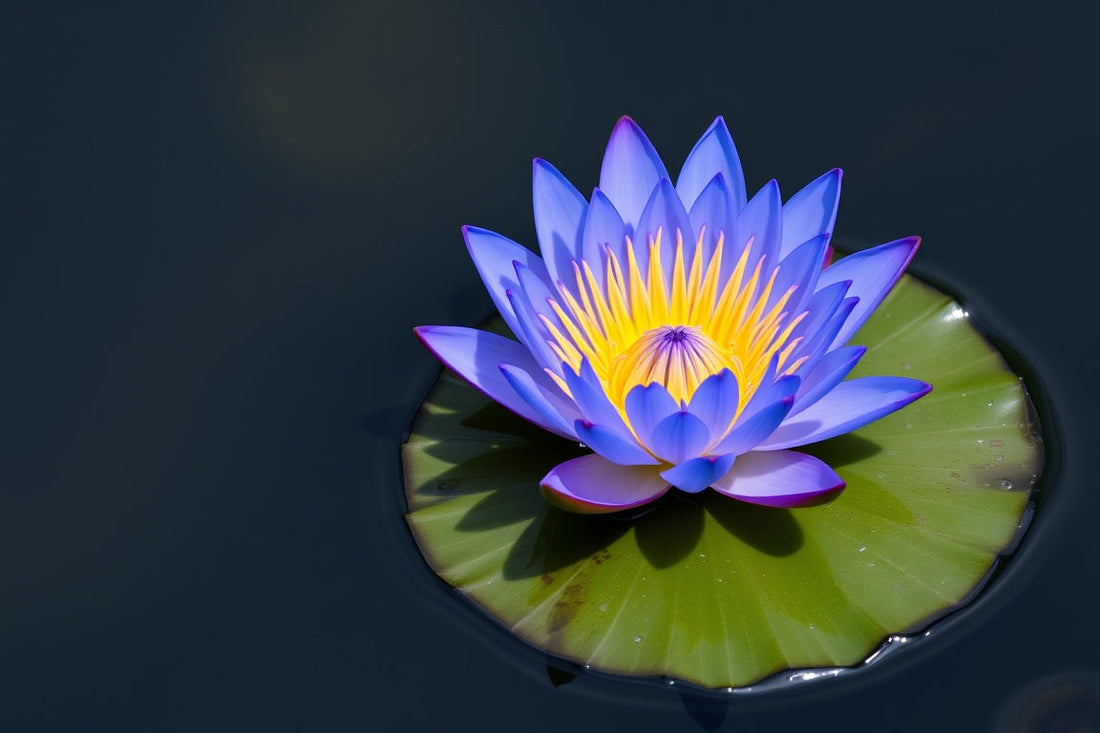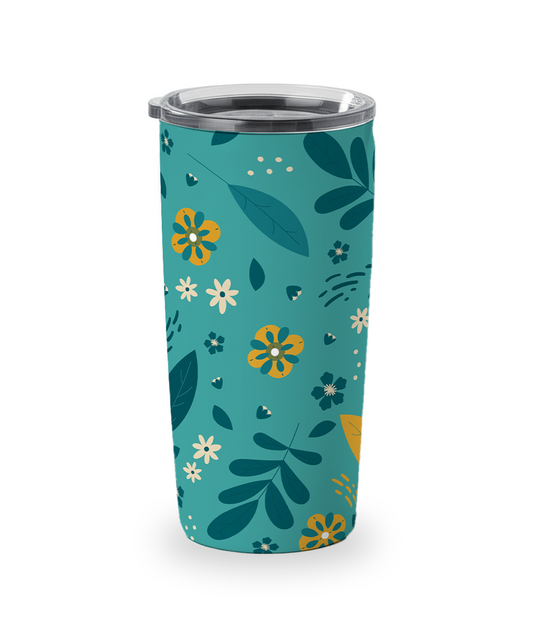
How To Grow Blue Lotus (Nymphaea caerulea)
Share
Embark on a journey to cultivate the captivating blue lotus, scientifically known as Nymphaea caerulea, a mesmerizing aquatic plant that brings tranquility and beauty to any garden.
This guide will provide you with the essential knowledge and practical steps to successfully grow and nurture your own blue lotus, transforming your water garden into a serene oasis.
Understanding the Blue Lotus
What is Nymphaea caerulea?
Nymphaea caerulea, commonly known as the blue lotus or Egyptian blue water lily, is an aquatic plant celebrated for its stunning blue flowers and rich history.
Revered in ancient Egyptian rituals, the blue lotus symbolized the sun’s journey and rebirth.
Thriving in tropical water, this enchanting water lily is a prized addition to ponds and water features, adding a touch of ancient mystique to any garden.
Characteristics of the Blue Waterlily
The blue waterlily distinguishes itself with its captivating blue petals and a vibrant yellow center. This tropical water lily typically blooms during the day, closing its flowers at night.
The lotus plants are rhizomatous perennials, meaning they have a creeping rootstalk, or rhizome, that grows horizontally.
Ideally suited for still or slow-moving water, it flourishes in full sun and warm water, making it a standout among other water plants.
Cultural Significance of the Lotus Flower
The lotus flower, particularly the blue lotus, carries profound cultural significance, especially in ancient Egyptian civilization where it was deeply embedded in religious and artistic practices.
Beyond its aesthetic appeal, the lotus flower was a symbol of creation, rebirth, and the sun god.
Its presence permeated ancient Egyptian rituals, art, and daily life, cementing its status as a sacred and revered emblem of spiritual awakening and enlightenment.
Creating a Perfect Water Garden
Choosing the Right Location for Blue Lotus
Selecting the ideal spot for your blue lotus is crucial for its health and vibrant flowers.
Nymphaea caerulea, or the Egyptian blue lotus, thrives in full sun, needing at least six hours of direct sunlight daily to bloom profusely.
Ensure the location is sheltered from strong winds that could damage the delicate lotus plants. Proximity to a power source may also be considered if you plan to add a water pump or fountain to enhance the beauty of your blue lotus water garden.
Water Quality and Depth Requirements
Maintaining optimal water quality is key to growing lotus successfully. The blue lotus prefers still or slow-moving water with a slightly acidic to neutral pH.
The ideal water depth for blue waterlily should be between 12 to 18 inches above the lotus tubers. Keep the water clean by regularly removing debris and algae.
Regularly check and adjust the water level, particularly during dry spells, to ensure the lotus plants remain adequately submerged.
Companion Plants for Water Lilies
Enhance your water garden by pairing the blue waterlily with compatible companion plants. Consider adding other aquatic plants like water hyacinths or dwarf papyrus to create a balanced ecosystem.
These plants not only add visual interest but also help to filter the water, benefiting your blue lotus.
Ensure that companion plants do not overshadow the blue lotus, as full sun is crucial for its growth and blooming throughout the growing season.
Growing Blue Lotus Indoors
Container Selection for Waterlilies
When growing lotus indoors, selecting the right container is essential for your blue lotus. Opt for a wide, shallow pot without drainage holes to keep the water and prevent soil erosion. The container should be large enough to accommodate the rhizome of the blue lotus, allowing it to spread and establish itself. A dark-colored pot can also help to keep the water temperature stable, mimicking the warm water conditions of its native habitat. Before planting, line the pot with a layer of loam to provide essential nutrients.
Lighting and Temperature Needs
Providing adequate lighting and maintaining the correct temperature are crucial when growing lotus indoors. Since the blue lotus thrives in full sun, supplement natural light with grow lights to ensure it receives at least six hours of light daily. Maintain a consistent water temperature between 75°F and 85°F (24°C to 29°C) to encourage healthy growth and blooming. Avoid placing the pot near drafts or cold windows, as the lotus plants prefer warm, stable conditions to flourish indoors.
Water Maintenance for Indoor Blue Lotus
Proper water maintenance is crucial for growing lotus indoors. Regularly check the water level and replenish it to keep the water consistent, accounting for evaporation. Use dechlorinated water to avoid harming the blue lotus. Additionally, fertilize your waterlily with an aquatic fertilizer every two to four weeks during the growing season. Regularly inspect the leaves for signs of pests or diseases, addressing any issues promptly to maintain the health of your blue lotus.
Care and Maintenance of Blue Lotus
Fertilization Tips for Thriving Blooms
Proper fertilization is essential for encouraging abundant flower blooms in your water garden. Use an aquatic fertilizer specifically formulated for water lilies, following the package instructions carefully.
The best time to fertilize is during the growing season, typically from spring to late summer. Avoid over-fertilizing, as this can harm the lotus plants and lead to algae blooms.
Apply fertilizer tablets near the lotus tubers, ensuring they are submerged and can slowly release nutrients into the water.
Pest Control and Disease Prevention
Maintaining a healthy blue lotus in your water garden involves vigilant pest control and disease prevention. Regularly inspect your lotus plants for signs of aphids, spider mites, or other common garden pests.
Treat infestations promptly with an appropriate aquatic-safe insecticide.
To prevent fungal diseases, ensure good water circulation and avoid overcrowding your water lilies. Remove any dead or decaying leaves promptly to keep the water clean and prevent the spread of disease among your lotus plants.
Pruning and Dividing Lotus Plants
Pruning and dividing your lotus plants are essential for their long-term health and vitality in your water garden. Regularly remove dead or yellowing leaves to keep the water clean and improve air circulation.
Every few years, consider dividing the rhizome of your blue lotus to prevent overcrowding. The best time to divide is in the spring, just before the growing season begins.
Carefully separate the rhizomes, ensuring each section has healthy roots and shoots, and replant them in fresh loam in its own pot.
Encouraging Blooming of Blue Lotus Flowers
Seasonal Considerations for Flowering
Understanding seasonal considerations is essential for encouraging prolific flower blooms. Nymphaea caerulea, or the Egyptian blue lotus, thrives in warm water and full sun during the growing season.
Ensure your water garden maintains a consistent water temperature to promote healthy growth and bloom. In cooler climates, consider moving potted lotus plants indoors to overwinter them in a temperature-controlled environment.
As spring arrives, gradually acclimate them back to the outdoor conditions to encourage blooming.
Common Reasons for Non-Blooming
Several factors can contribute to a blue lotus not blooming as expected in your water garden. Insufficient sunlight is a primary cause, as blue lotus needs at least six hours of full sun daily to produce blooms. I
nadequate fertilization or nutrient deficiencies can also inhibit flowering. Check the water depth and ensure it is appropriate for the size of your lotus plants.
Finally, pests or diseases can weaken the lotus plants, preventing them from blooming. Address these issues promptly to encourage flowering.
Enhancing Color and Size of the Blue Lotus Flower
To enhance the color and size of your blue lotus flower, focus on providing optimal growing conditions in your water garden. Ensure the lotus plants receive ample full sun and warm water.
Use an aquatic fertilizer rich in phosphorus to promote vibrant blooms. Keep the water clean and free of algae, as algae blooms can compete with the lotus plants for nutrients. Consider adding a small amount of iron chelate to the water, as iron can intensify the color of the blue waterlily petals.
How to Grow Blue Lotus
The blue lotus, scientifically known as Nymphaea caerulea, is a stunning aquatic plant often found in ponds and water gardens. Its beautiful blooms and rich history in ancient Egyptian culture make it a captivating addition to any water feature. To successfully grow blue lotus, you need to provide the right conditions for these tropical water lilies.
Choosing the Right Environment
Blue lotus thrives in still or slow-moving water, so it's essential to select a suitable pond or water garden location. Ensure the water depth is around 30cm and keep the water temperature warm, ideally between 20-30°C. A sunny spot is crucial, as blue lotus requires at least 6 hours of direct sunlight daily for optimal growth.
Planting Blue Lotus Seeds
You can start by germinating blue lotus seeds. Soak the seeds in warm water for 24 hours to soften the outer shell, which helps them sprout more effectively. Once germinated, plant your lotus in a pot filled with a heavy soil mix or aquatic fertilizer, ensuring the seeds are just below the surface. If using a tuber, submerge it with the top of the pot exposed to sunlight.
Maintenance and Care
During the growing season, which typically begins in late spring, it’s important to fertilize your blue lotus regularly. Use an aquatic fertilizer to provide the necessary nutrients. Monitor the water level, ensuring it remains stable, and adjust as needed. If you notice the plants starting to die back in cooler temperatures, you may need to overwinter them indoors or in a warmer area.
Conclusion
If you want to skip the process of growing blue lotus, you can buy blue lotus tea right on our website. However, if you are interested in the journey of cultivating this beautiful plant, there are several steps you can follow to successfully grow blue lotus in your garden or water feature. First, ensure you have a suitable environment, as blue lotus thrives in warm, sunny conditions with plenty of water. You will need to start with healthy seeds or tubers and plant them in nutrient-rich soil, preferably in a container that can hold water. Regular maintenance, such as monitoring water levels and providing adequate sunlight, is essential for the growth of blue lotus. With patience and care, you can enjoy the stunning blooms and tranquil beauty of blue lotus in your own backyard.

